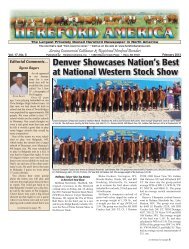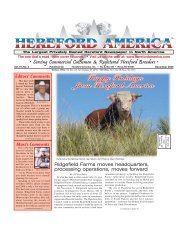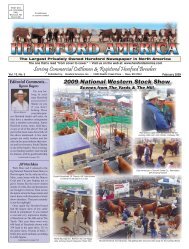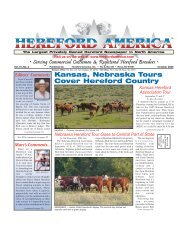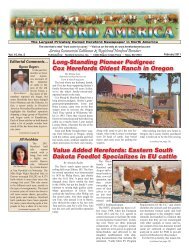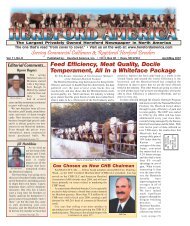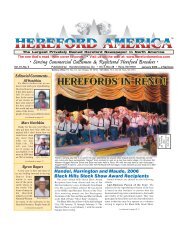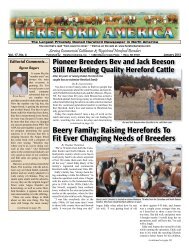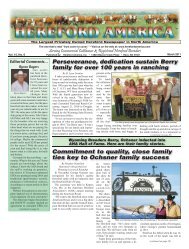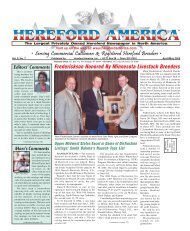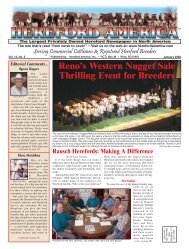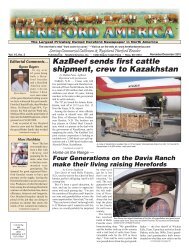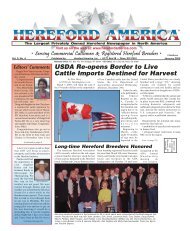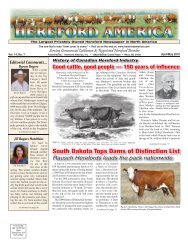April/May 2008 Issue (pdf - 7794 kb)... - Hereford America
April/May 2008 Issue (pdf - 7794 kb)... - Hereford America
April/May 2008 Issue (pdf - 7794 kb)... - Hereford America
Create successful ePaper yourself
Turn your PDF publications into a flip-book with our unique Google optimized e-Paper software.
22 • www.herefordamerica.com HEREFORD AMERICA • <strong>April</strong>/<strong>May</strong> <strong>2008</strong><br />
(continued from page 17)<br />
Q: Is there a specific line of cattle that<br />
is associated with IE?<br />
Because the spontaneous mutation<br />
rate is very rare, specific mutations<br />
occur only within a single individual,<br />
called a founder. As such, within the<br />
population, all individuals that have the<br />
mutation can be traced to the founder.<br />
Thus, specific mutations are unique to<br />
certain “lines” within populations. In<br />
the case of IE, all individuals with the<br />
mutation can be traced to a single<br />
individual born in 1982.<br />
Within the <strong>Hereford</strong> breed there are<br />
many lines of cattle that are frequently<br />
named based on the origin of the<br />
genetic resource. The IE founder<br />
individual is classified as a Line 1<br />
animal, named for the line-breeding<br />
experiment that was initiated at the Fort<br />
Keogh Livestock and Range Research<br />
Laboratory in Miles City, Montana.<br />
However, it is very important to<br />
recognize that cattle tracing back to the<br />
IE founder individual only represent a<br />
very small fraction of the population<br />
of <strong>Hereford</strong> cattle classified as Line 1.<br />
Furthermore, this founder individual<br />
was born outside of the Miles City<br />
Research Station and no animals within<br />
the Miles City herd have tested as IEC.<br />
Thus, referring to IE as a “Line 1”<br />
problem is blatantly incorrect and<br />
should be vigorously denounced.<br />
Additionally, it is equally incorrect to<br />
suggest that the IE mutation was<br />
“caused” by the presence of non-Line<br />
1 germplasm within the founder<br />
individual. In fact, molecular evidence<br />
(i.e., DNA sequence information)<br />
generated while conducting the IE<br />
research clearly indicates that the<br />
mutation occurred on a chromosome<br />
originating within Line 1 genetic<br />
material. In summary, IE is restricted<br />
to a line of cattle defined by their<br />
relationship to a specific founder<br />
individual; however breeders should be<br />
cautioned against referring to IE<br />
relative to the broader classification of<br />
Line 1 cattle within the <strong>Hereford</strong> breed.<br />
Q: What is the frequency of IE within<br />
the <strong>Hereford</strong> breed?<br />
As indicated above, the IE mutation<br />
is restricted to a relatively small<br />
subpopulation within the breed. Thus,<br />
it is difficult to accurately estimate the<br />
frequency of the mutation for the entire<br />
<strong>Hereford</strong> population. Since the<br />
development of the DNA test for IE,<br />
almost 10,000 animals have been tested<br />
for the mutation. The vast majority of<br />
these samples were submitted based on<br />
the presence of IE-suspect relatives<br />
within their pedigrees. Approximately<br />
15% of the tested individuals were<br />
tested as IE-Carrier (IEC). Although<br />
this appears to be a relatively high<br />
frequency, it is important to remember<br />
that this estimate is biased due to<br />
selected testing of suspect cattle only.<br />
On the other hand, it is also important<br />
to recognize that with this moderate<br />
frequency of the mutation, IE should<br />
not be considered as a “negligible”<br />
issue within the breed.<br />
Q: Is there a publicly available list<br />
of animals that have been tested for<br />
IE?<br />
Currently, there is not a publicly<br />
available list indicating the IE status of<br />
specific individuals that have been<br />
tested. However, since the development<br />
of the IE test, the <strong>America</strong>n <strong>Hereford</strong><br />
Association Staff and Board have been<br />
actively working to establish policies<br />
regarding the listing of both IEF and<br />
IEC individuals.<br />
Q: Do other breeds have IE?<br />
Although there are documented<br />
“epilepsy-like” disorders in other cattle<br />
breeds, it is highly unlikely that the<br />
underlying genetic basis is the same as<br />
that found in <strong>Hereford</strong> cattle.<br />
Furthermore, while a disorder may be<br />
generally described as epilepsy, each<br />
condition may have subtle differences<br />
in the pathology or presentation. This<br />
would indicate differences in<br />
underlying causes including both<br />
genetic and environmental conditions.<br />
Also, as mentioned above, spontaneous<br />
mutation is a relatively rare event.<br />
Thus, it would be<br />
virtually impossible for<br />
the same mutation to<br />
occur in another<br />
individual or highly<br />
unlikely for an<br />
independent mutation to<br />
occur within the same<br />
gene affected in IE.<br />
Additionally, because the<br />
mutation causing IE can<br />
be traced to a relatively<br />
recent founder individual<br />
within the <strong>Hereford</strong><br />
breed, it would also be<br />
unlikely that seizure<br />
disorders described in<br />
other breeds prior to 1982<br />
would be the same as IE.<br />
Q: Is it acceptable to use<br />
an IEC animal in a<br />
registered breeding<br />
program?<br />
The general purpose of<br />
every breeding program<br />
is to accumulate genetic<br />
value from one<br />
generation to the next. To<br />
accomplish this goal,<br />
individual breeders use a<br />
number of criteria (e.g.,<br />
phenotype, performance,<br />
EPDs, etc.) for making<br />
selective matings<br />
between parent<br />
individuals. For some<br />
breeders, an animal that<br />
is IEC has no value and<br />
thus they will choose not<br />
to use them. Over the<br />
long-term, this should be<br />
the goal of all seedstock<br />
producers. However, at<br />
the same time, breeders<br />
should also recognize that there may be<br />
IEC animals with superior genetic merit<br />
for other traits that cannot be found<br />
among IEF animals. Availability of a<br />
DNA test for IE allows breeders to use<br />
IEC animals in order to extract the<br />
positive genetic merit for other traits<br />
while directly selecting against IE by<br />
testing the offspring and selecting those<br />
with the highest merit that are IEF.<br />
This being said, breeders might<br />
consider the following guidelines for<br />
using IEC individuals. In regard to<br />
bulls, young or unproven individuals<br />
should be removed from the breeding<br />
population as soon as possible. Proven<br />
herd sires should be used on a limited<br />
basis until a potential IEF replacement<br />
can be produced. Females that are<br />
below average for performance should<br />
be culled or moved into a commercial<br />
production environment. Above<br />
average females can be bred to IEF<br />
bulls until a suitable IEF replacement<br />
is produced or potentially used as<br />
recipients for an ET program. Very few<br />
elite IEC females will merit use as ET<br />
donors. It should be noted that in all<br />
these situations, increased management<br />
of these animals will be required to<br />
insure control over the inadvertent<br />
spread of IE.<br />
Get more bang for your advertising buck<br />
in the publication that gets results for you!<br />
Many of our readers and advertisers say it’s the<br />
<strong>Hereford</strong> publication they read “from cover to cover.”<br />
Our next issue comes out in August.<br />
Check our website or call for current rates<br />
and information.<br />
Call Marc or Taylor for more<br />
information on websites or<br />
video services.<br />
North <strong>America</strong>’s Largest Privately Owned <strong>Hereford</strong> Newspaper<br />
Jill & Marc Hotchkiss • Byron & Pauline Bayers • Taylor Vroman<br />
HC 3 Box 38 • Reva, SD 57651<br />
605/866-4495<br />
Malynda Carter, Ad Sales<br />
605/925-7016 or 701/351-4758 (cell)<br />
Q: How about using IEC animals in<br />
a commercial program?<br />
Although it would be best to limit the<br />
use of IEC animals in any breeding<br />
program, IEC individuals may have<br />
some utility within the commercial<br />
production environment where calves<br />
are destined for terminal use. Because<br />
IE is a recessive genetic defect, calves<br />
affected with IE cannot be produced if<br />
at least one of the parents is IEF. Thus,<br />
in a commercial production<br />
environment, producers would not need<br />
to worry about losses due to mortality<br />
of affected calves. Because this IE<br />
mutation is only found within <strong>Hereford</strong><br />
cattle, the use of IEC animals in an<br />
intercross crossbreeding system would<br />
not produce any affected calves in the<br />
initial two-breed cross. The danger in<br />
using IEC animals in these situations<br />
is the potential for retention of<br />
replacement animals that may be IEC.<br />
If these IEC replacements were to be<br />
mated back to another IEC individual,<br />
affected calves may be produced.<br />
Therefore, with appropriate breeding<br />
management practices, IEC individuals<br />
can be used without economic<br />
consequence.<br />
Photo by Colin Hoffman, Leola, SD



